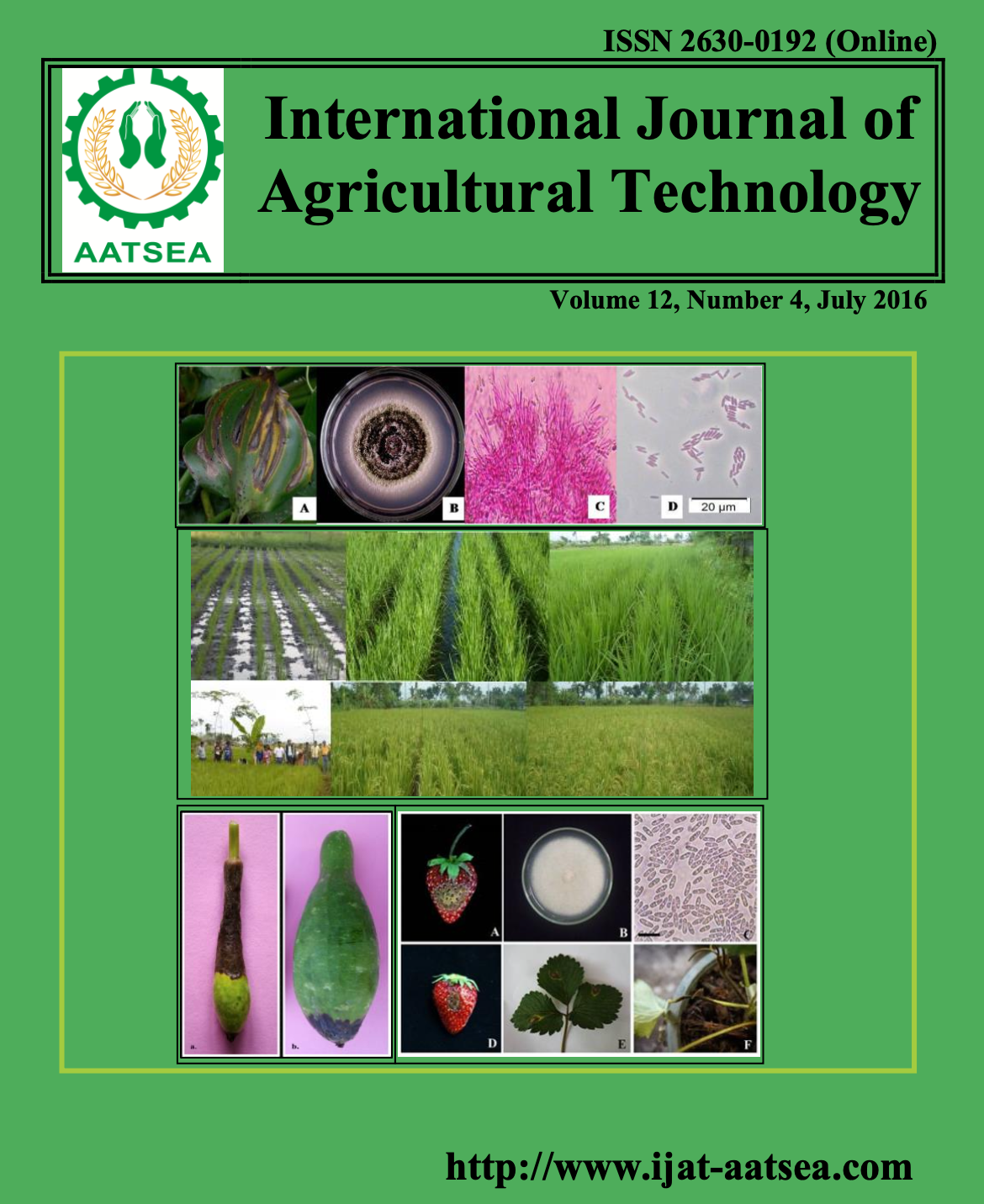Two new bottle gourd fruit rot causing pathogens from Sub-Himalayan West Bengal
Main Article Content
Abstract
Colletotrichum sp.and Fusarium sp. are the two major fungi that cause bottle gourd fruit rot. Typical fruit symptoms include hard, sunken, and dark brown to black patches gradually covering entirely the whole fruit. Pathogen isolates were obtained from diseased bottle gourd fruits, on PDA medium forming a white to gray colonies. The conidia of Colletotrichum sp. were hyaline in color, cylindrical with both apices rounded. On the other hand the conidia of Fusarium sp. were also hyaline, beaked and having transverse septa. Pathogenicity tests with representative isolates were conducted on symptomless fresh bottle gourd fruits. Both the tested fungal pathogen caused fruit rot on bottle gourd fruit. Koch’s postulates were fulfilled by reisolation of the pathogens from the test fruits. PCR analysis (using universal primer set ITS1/ ITS4) of genomic DNA from the pathogens and bioinformatic analysis further confirmed presence of the pathogens. These two fungi as fruit rot causing pathogens in bottle gourd are being reported for the first time.
Article Details

This work is licensed under a Creative Commons Attribution-NonCommercial-NoDerivatives 4.0 International License.
References
Amadi, J. E., Nwaokike, P., Olahan, G S. and Garuba T. (2014). Isolation and identification of fungi involved in the post-harvest spoilage of guava (Psidium guajava) in Awka metropolis. International journal of engineering and applied sciences 4:7-12.
Dellaporta, S. L., Wood, J. and Hicks, J. B. (1983). A plant DNA minipreparation: version II. Plant Molecular Biology Reporter1:19-21.
Hawa, M. M., Salleh, B. and Latiffah, Z. (2010). Characterization and intraspecific variation of Fusarium semitectum (Berkeley and Ravenel) associated with red-fleshed dragon fruit (Hylocereus polyrhizus [Weber] Britton and Rose) in Malaysia. African Journal of Biotechnology 9:273-284.
Heiser, C. B. (1979). The gourd book. University of Oklahoma press. Norman. Okla.
Ignjatov, M., Milošević, D., Nikolić, Z., Gvozdanović-Varga, J., Jovičić, D. and Zdjelar, G. (2012). Fusarium oxysporum as Causal Agent of Tomato Wilt and Fruit Rot. Pestic. Phytomed 27:25-31.
Kaur, N., Dhiman, S. J. and Khurana, D. S. (2011). Physiological and Biochemical Traits Analysis of Capsicum annum L. Germplasm for Resistance to Colletotrichum capsici. Journal of Cell & Plant Sciences 2:12-21.
Ling, K. S. and Kousik, C. S. (2008). First report of southern blight on botte gourd (Lagenaria siceraria) caused by Sclerotium rolfsii in South Carolina. Plant disease 92:656.
Maheshwari, S. K., Choudhary, B. R. and Singh, D. (2013). Occurrence of fungal diseases of bottle gourd in Rajasthan. Progressive horticulture 45:206-208.
Masyahit, M., Sijam, K., Awang, Y., Ghazali, M. and Satar, M. (2009). The First Report of the Occurrence of Anthracnose Disease Caused by Colletotrichum gloeosporioides (Penz.) Penz. & Sacc.on Dragon Fruit (Hylocereus spp.) in Peninsular Malaysia. American Journal of Applied Sciences 6:902-912.
Miles, T. and Schilder, A. (2008). Anthracnose Fruit Rot (Ripe Rot). Michigan blueberry factsE-3039:1-4.
Milind, P. and Kaur, S. (2011). Is bottle gourd a natural guard? Int Res J pharmacy 2:13.
Saitou, N. and Nei, M. (1997). The neighbor-joining method: a new method for reconstructing phylogenetic trees. Molecular biology and evolution 4:406-425.
Pallem, C., Chabanahalli, S. C., Reddi, B., Hanumanthappa, S. and Rajendra, P. P. (2012). Morphological and molecular characterization of Colletotrichum gloeosporioides (Penz) Sac. isolates causing anthracnose of orchids in India. Biotechnol Bioinf Bioeng 2:567-572.
Peres, A. N. R., Kuramae, E. E., Dias, M. S. C. and De Souza, N. L. (2002). Identification and characterization of Colletotrichum spp. Affecting fruit after harvest in Brazil. J. Phytopathology 150:128-134.
Prajapati, R. P., Kalariya, M., Parmar, S. K. and Sheth, N. R. (2010). Phytochemical and pharmacological review of Lagenaria siceraria. Journal of Ayurveda and Integrative Medicine 1:266-272.
Rita, W. S., Suprapta, D. N., Sudana, I. M. and Swantara, I. M. D. (2013). First Report on Fusarium solani, a Pathogenic Fungus Causing Stem Rot Disease on Dragon Fruits (Hylocereus sp.) in Bali.Journal of Biology, Agriculture and Healthcare 3:93-99.
Sharma, R., Mahla, H. R., Mohapatra, T., Bhargva, S. C. and Sharma, M. M. (2003). Isolating plant genomic DNA without liquid nitrogen. Plant Molecular Biology Reporter 21:43-50.
Tamura, K., Stecher, G., Peterson, D., Filipski, A. and Kumar, S. (2013). MEGA6: Molecular Evolutionary Genetics Analysis Version 6.0. Molecular Biology and Evolution 30:2725-2729.
Thiyam, B. and Sharma, G. D. (2013). Isolation and Identification of Fungi Associated with Local Fruits of Barak Valley, Assam. Current World Environment 8:319-322.
Zhang, L., Song, J., Tan, G., Han, X. and Shen, J. (2014). Characterization of Colletotrichum gloeosporioides responsible for anthracnose disease of Trichosanthes kirilowii Maxim in central China. Phytoparasitica 42:549-558.
Živković, S., Stojanović, S., Ivanović, Ž., Trkulja, N., Dolovac, N., Aleksić, G. and Balaž, J. (2010). Morphological and Molecular Identification of Colletotrichum acutatum from Tomato Fruit. Pestic. Phytomed 25:231-239.


